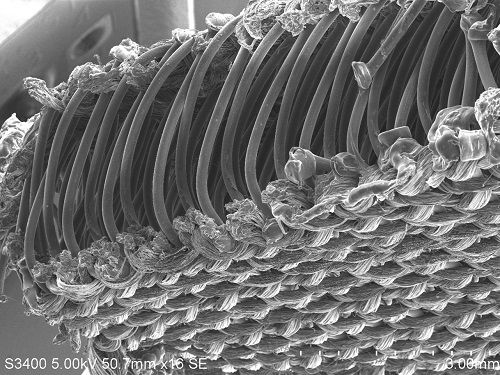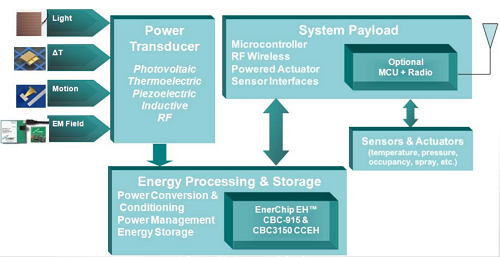BY STEPHAN OHR,
Electronic Products Correspondent
If it’s not a robot or machine tool, chances are that your Internet of Things project is (or incorporates) a remote sensor node. It will likely use miniaturized batteries to power itself. The goal of energy harvesting in IoT projects, ideally, is to eliminate batteries altogether. More likely, the energy source would be called upon to supplement the battery’s output; to make it last longer in use. Thus, developments in energy harvesting have two focal points: On one hand, we’re looking at the energy conversion itself (not a mature technology, but it’s not leaving us anytime soon). On the other hand, we’re looking at the ultra-low-power sensor node components, whose nano-amp power consumption presents a minimal tax on battery life.
Ironically, some remote sensor nodes are referred to as “energy harvesters” (“EH” in company product literature). They use components that run on a minimal amount of current — like microcontrollers that run on microamps per MHz. The promotional theme of EH development kits is not the techniques for converting ambient energy into a usable DC voltage, but rather the system components — sensors, signal-conditioning ICs, micropower controllers, and communications ports — whose ultra-low power consumption renders batteries practically obsolete.
Truth is, the technology for energy harvesting is actually still in its infancy, though there are several evolving techniques: Photovoltaic panels, for example, can be harnessed for large-scale power conversion. Currently, rooftop solar panels can convert enough energy to power a home or office. But large-scale energy storage remains a challenge. Capacitive storage systems — some as large as a dump truck — provide usable long-term energy storage, but for mobile systems (embedded), they are hardly portable.
Energy-harvesting technology still keys on the size of the energy-gathering transducer. High-wattage systems depend on larger energy converters: Solar cells provide 100 mW per square centimeter — the square gives enough to power a pocket calculator. But the amount of energy that you can collect via harvesting goes down from there. Thermal gradient harvesters provide 10 mW per square centimeter; vibration (piezo electric) provide 100 microwatts (100µW) per square. And radio frequency (RF) energy harvesters — seemingly popular because there is just so much energy to collect — yield 0.1 µW (100 picowatts) per square centimeter.
Energy-harvesting techniques
While not particularly high, the efficiency of ambient energy converters is conditioned by the environments in which they operate. To be perfectly ridiculous, you’re not going to harvest much energy from a solar cell locked in an indoor closet, though it is possible (using dye sublimation techniques, DSSC) to tune the sensitivity of the solar converters to indoor lighting wavelengths such as those emitted by fluorescent tubes (about 600 nm).
Piezo-electric devices (a “sandwich” of dissimilar metals) can generate usable voltages by a mechanical deformation, but the electricity harvested is still very small in comparison with the area and deformation of the sensor. You can recharge your cellphone battery with the energy generated by piezo devices in your shoe, but that’s a week-long effort.
Piezo-electric fibers can make electricity-producing fabrics, according to researchers at the University of Bolton in the U.K (see Fig. 1 ). Fig. 1: An interesting new trend among piezo-electric motion detectors is their incorporation into fabrics, a technology that would support wearable applications. Image Credit: University of Bolton.
Fig. 1: An interesting new trend among piezo-electric motion detectors is their incorporation into fabrics, a technology that would support wearable applications. Image Credit: University of Bolton.
Thermal gradients, a different type of “sandwich,” claims high conversion efficiency and high output. It uses the Seebeck effect, with a semiconductor sandwiched between a hot plate and a cold plate. While advocates claim high conversion efficiency, the amount of electricity harvested is a function of the hot-cold plates — their size and the temperature differential between hot and cold metal. The bigger the differential, the larger the amount of electrical energy available. But this type of energy conversion works best where there is a BIG temperature differential — as with a hot plate in the Canadian arctic.
Applications for piezo-electric energy harvesters include motion components and vibration monitors. Wireless HVAC sensors and mobile asset tracking are identified as viable sensors in manufacturers’ product literature; the piezo-electric devices might seem better-suited for sensing mechanical force and deformations rather than gaseous conditions (like temperature and humidity).
Smart building applications
Energy harvesters for smart buildings are predominantly HVAC sensors that monitor conference room occupancy (an infrared function), as well as air temperature, humidity, and CO2 content. Other smart building sensors monitor lighting (which includes window light, room light, and shade controls). Security sensors look at illicit room occupancy, and intrusion. Utility monitoring performs meter reading and off-peak control of electrical power usage. EH systems offering “platforms as a service” (PaaS) interact with cloud services, which enable Bluetooth and other network communications.
Mailbox functions (like equipment service tags) work in conjunction with microcontrollers. For data logging applications, EH modules will support cold-chain time and temperature monitoring for frozen food shipping. Medical applications include smart patches, in which the sensor looks at blood glucose, body temperature, moisture, pH, and oxygen. (For instance, a gas detector reference design is available on the web from Texas Instruments.)
Another interesting trend is in the use of micro embedded batteries in which you need to cut power consumption. Silicon batteries, like those produced by Cymbet, will take a charge in-circuit from a variety of sources (see Fig. 2 ). Fig. 2: Zero-power sensors enable energy to be harvested from almost any environment. Energy sources include light, vibration, flow, motion, pressure, magnetic fields, and RF. Image Credit: Cymbet.
Fig. 2: Zero-power sensors enable energy to be harvested from almost any environment. Energy sources include light, vibration, flow, motion, pressure, magnetic fields, and RF. Image Credit: Cymbet.
Keep it small
As a technology development, analog semiconductor makers have put their research and development efforts on ultra-low-power semiconductors rather than solar cells, or specially tuned vibration sensors. Rather than utilize a harvester as large as a railroad car, wearables, remote sensor nodes (including mesh networks), mobile sensors (like gas detectors), and motion detectors demand small (even microscopic) energy converters.
Consequently, the advisory that semiconductor makers publish on their data sheets and white papers emphasizes ultra-low power consumption. Signal-conditioning ICs like Analog Devices’ LTC3588, Maxim’s MAX17710, or Texas Instruments’ bq25504 emphasize ultra-low current consumption, even with multiple mixed loads. Literature for the 3588, for example, suggests that it is optimized for piezo-electric inputs, though their high impedance could be used with a variety of energy sources. The 3588 is, essentially, a low-power AC-DC converter with 450-nA quiescent current. It’ll take inputs from 2.7 V to 28 V, outputs down to 1.8 V — with no more than a 400-mV drop-out.
Maxim claims that its MAX17710 will manage the poorly regulated sources with output levels ranging from 1 µW to 100 mW. The device can deliver over 20 mA from a variety of energy-conversion sources. TI’s BQ25504 similarly is essentially an ultra-low-power, high-efficiency DC-DC that provides continuous energy harvesting from low-input sources (e.g., 80 mV). Its quiescent current is less than 330 nA.
EH processors
Specifications for MCU power consumption similarly focus on ultra-low-power applications. Technically, power consumption is a combination of the current consumed (micro- or nano-amperes) times the voltage generated (often in millivolts). On the receiving end of an energy harvester, that number could be in microvolts.
The common IoT design goal is to minimize the size and current consumption of the devices used to activate the node, but this can be enough to charge an embedded battery and/or a variety of low-power components.
Variations of the ARM Cortex M tout their seemingly infinitesimal power consumption: Atmel 32-bit ARM Cortex M0+, for example, consumes 35 µA per MHz in the active processing mode. The processors consumes 200 nA overall in sleep mode. If we’re talking about preserving battery life, the low power of this microcontroller, says Ars Technica, takes that capability out to not just years but decades.
An energy-harvesting PMIC for wireless sensors from Cypress Semiconductor, another example, features a long interval interrupt timer mode that can extend battery life by using standby for long intervals. It operates alongside a low-power microcontroller, like the Cypress PSoC.
Texas Instruments’ own version of the ARM Cortex M, the MSP432, boasts an 80-µA-per-MHz active current consumption and an 660-nA current draw in standby.
Of course, TI advises in a tutorial on microcontroller power consumption that actual processor power consumption reflects an aggregate of several different operating phases. These would include active and sleep modes. In embedded systems applications, the microcontroller may hibernate for most of its life. Sleep-mode power consumption may then be the more useful spec, rather than the response to multi-MHz clocking.
Consequently, extending battery life may appear to be entirely function of proportion of time spent in sleep and activity. TI advises that microcontroller power consumption is “not one number.”
Advertisement





